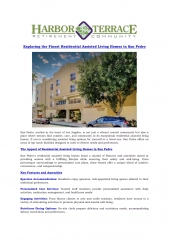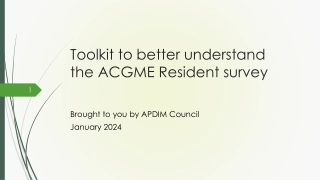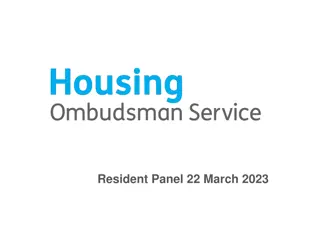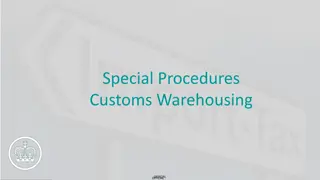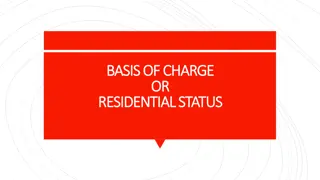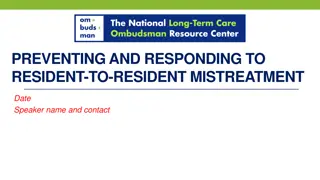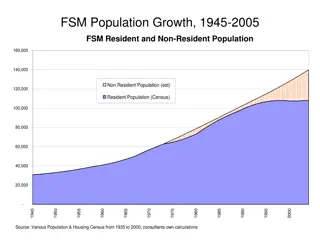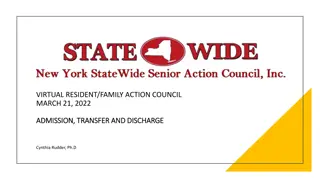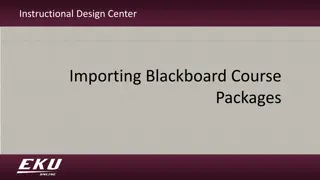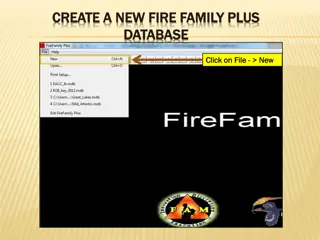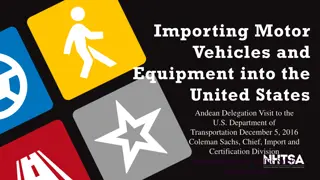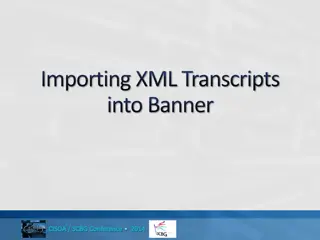
Importing into Canada for Non-Residents
Learn about the advantages, complexities, and taxes involved in importing goods into Canada as a non-resident. Discover how streamlining the process can benefit both you and Canadian clients, and get insights into GST/HST taxes and important questions to consider before venturing into the Canadian market.
Download Presentation

Please find below an Image/Link to download the presentation.
The content on the website is provided AS IS for your information and personal use only. It may not be sold, licensed, or shared on other websites without obtaining consent from the author. If you encounter any issues during the download, it is possible that the publisher has removed the file from their server.
You are allowed to download the files provided on this website for personal or commercial use, subject to the condition that they are used lawfully. All files are the property of their respective owners.
The content on the website is provided AS IS for your information and personal use only. It may not be sold, licensed, or shared on other websites without obtaining consent from the author.
E N D
Presentation Transcript
NON-RESIDENT IMPORTING INTO CANADA
WHAT DOESTHIS MEAN FOR YOU? Canada s importers have much more buying power and are realizing something that foreign companies have been implementing for many years They are now requesting/requiring that their goods be delivered to their door duties, taxes and transportation included. They want a more seamless and hassle free transaction
ADVANTAGES FOR YOU Increased market share by making it simpler and easier for Canadian clients to buy from your clients and perhaps handling the freight and customs from A to Z Enhancing their customer experience with you thereby increasing the chance of customer loyalty and retention You have increased control over your sales, profits and expenses
WHAT MAKES IT SO COMPLICATED? The GST and HST Taxes!
WHAT IS GST/HST? GST (Goods and Services Tax) is a 5% tax assessed on most goods and services in Canada including all imports It is payable at time of importation Non taxable goods are referred to as zero-rated supplies ex: basic groceries, prescription drugs, International Freight & Transportation Services and Canadian Goods Returned
WHAT IS HST? HST stands for Harmonized Sales Tax It is part of the GST Tax System and is administered through the CRA (Canada Revenue Agency). It only applies to sales in certain provinces across Canada Ontario 13% Atlantic Provinces (New Brunswick, Prince Edward Island, Newfoundland, & Labrador) 15%
THE MOST IMPORTANT QUESTIONS TO ASK WHO WILL BE THE IMPORTER OF RECORD? WHAT IS YOUR ANTICIPATED VOLUME (# OF SHIPMENTS INTO CANADA) ? WHAT ARE YOUR TERMS OF SALE (INCOTERMS)?
SHOULD YOUR CLIENT REGISTER? Most companies who chose to be NRI will choose to voluntarily register for GST/HST and fall into the category of carrying on business outside Canada since they regularly solicit orders for goods to be exported or delivered to Canada on a delivered duty paid basis
SHOULD YOUR CLIENT REGISTER? If your client anticipates having more than 2 shipments into Canada where the Foreign Company is acting as the Importer of Record, you should have them register If they do NOT register, they cannot charge the GST, they cannot collect the GST, but they still have to pay the GST upon importation
HOW DOES THE GST WORK? Like the European VAT Can be claimed back by the Canadian Importer or Non Resident Importer providing they are registered for GST with Revenue Canada. Non Resident importers must charge their Canadian customer the GST/HST depending on what province they are selling to The GST/HST must be shown as a separate line on the commercial invoice ONLY the GST is paid to customs when the goods are imported You will receive a form from the CRA where you will indicate all the GST you paid (input tax credit) to Customs on import versus all the GST/HST you collected from your clients (plus/minus) This amount will result in either a remittance to the Government or a refund You can choose to file your GST/HST monthly, quarterly or yearly depending on the disbursements involved. Most companies chose quarterly reports.
BENEFITS The foreign importer gets the 5% GST that they paid on import refunded to them They can also get back any GST paid for goods that were exported back into the country from which they were imported. (for example replacement, damaged, rejected).
OBLIGATIONS The NRI must establish an accounting system to: Identify all the taxes they collected on sales Identify all taxes they paid (called an Input Tax Credit). They will need to provide Customs with a security deposit of $5000.00 minimum or a surety bond (Cost is approximately $500.00 per year). Must remain registered for the GST for at least 1 year
OBLIGATIONS Must maintain books and records in Canada for 6 years Non-Residents can request permission to maintain books and records outside Canada by filling out a request form Canadian Customs Brokers can also remit GST returns on behalf of their clients as well as maintain their books & records
HOW TO REGISTER Fill out an application (RC1) to request a GST/Business number. Usually takes about 3 to 4 weeks to get a GST Number back, however the NRI is eligible to start claiming back any GST they paid the minute Revenue Canada receives their application Any GST they have paid before sending that application to Revenue Canada cannot be claimed back retroactively, so it is important to make sure to apply before your 1stimportation into Canada
GST/BUSINESS NUMBER Once the NRI receives this number, it will serve as an identification number for the company with Revenue Canada (like your U.S. IRS# or European VAT #) It will also serve as an Importer Number (application must be made) You will also need a Customs Bond for duties and taxes which costs $500.00.
HOW DO I SIMPLIFY THE PROCESS? The entire registration process from A to Z can be taken care of by a Canadian Customs Broker providing they are familiar with the rules and regulations pertaining to Non-Resident Importers Example of client who lost $30,000.00 because the broker did not register them In any case if your client decides to be the Importer of Record, they will need a Canadian Customs Broker and they will need a Canadian Power of Attorney signed by an officer of the Company
SCENARIO 1 Foreign vendor sells to a company in Canada where that Canadian company acts as the Importer of Record however the goods are drop-shipped from another country to Canada Canadian importer is responsible for customs clearance, duties and taxes Commercial Invoice or Canada Customs Invoice is required (the 1stsale rule does not apply in Canada, has to be the invoice of sale between the US Company and the Canadian Company). NAFTA is not applicable unless the goods are coming from Mexico however other tariff treatments may be applicable according to agreements with other countries (ex: GPT China, LDDC Bangladesh ).
SCENARIO 2 Foreign Company planning to act as the Importer of Record once or twice No need for Foreign Company to register for GST Use the flow through method where they are allowed to charge their Canadian client the GST of 5% and the Canadian client can use the B3 (7501) as proof to claim back their GST from the Canadian Government In addition, a Canadian POA is required (signed by officer) All the requirements mentioned in Scenario 1 will be applicable Full legal company name, address, telephone number and name of the President of the Company will be required Once that is done, we can apply for an Importer Number on behalf of the client *Note: an Importer Number and GST Number are not the same thing
WAYS OF DEALING WITH GST IN THIS CASE Send the shipment DDP excluding GST which will be for the account of the consignee Have the Customs Broker bill everything back to the agent except for the GST which the Canadian Broker will bill to the Consignee in Canada
THINGS TO REMEMBER 1. LVS SHIPMENTS: Low Value Shipments are defined as any shipment that is under $2500.00 CAD and come in by Fed Ex, UPS or DHL and are approved by customs to pass under the LVS system Shipments subject to OGD s or paperwork that reads Value for Customs $1.00 will usually get refused on the LVS system Shipments are delivered to client prior to the broker doing any paperwork for Customs Rules different than the USA
THINGS TO REMEMBER 2. Importer Numbers: Customers using their Importer Number for the 1sttime will automatically get referred for exam at least for the 1stshipment if not the 1stfew shipments which can lead to expensive examination charges in some cases. 3. Compliance: When you become the Importer of Record it automatically transfers any and all responsibility for the import to your company in the eyes of Canada Customs; for example tariff classification, origin, tariff treatment .
THINGS TO REMEMBER 4. End Use: We have annex codes or certain classification codes based on end use that reduce or remove the customs duty on certain items so where applicable, it s important to ask the client. ex: all fabric for use in the manufacture of clothing is now duty free from all Countries 5. Valuation: The commercial invoice must reflect the true selling price between the Vendor and the client in Canada If there is no sale price prior to the shipment leaving for Canada, you can use the 1stsale rule but only if the goods are shipped directly from their point of loading and have not cleared U.S Customs.
THINGS TO REMEMBER 6. Payment of Duties & Taxes: An NRI obtains an annual bond approved by Canadian Customs which allows them to pay all duties and taxes owing once a month It is very practical because the importer has no credit limit as far as duties and taxes are concerned, and they make only 2 checks per month. (one to the Receiver General and one to the Customs Broker)
THINGS TO REMEMBER 7. Permits: Some goods will require Import Permits ex: steel 8. Prohibited Items: Ostrich or Peacock feathers (tariff code 9897.00.00.00) 9. Anti Dumping or Countervailing Duties: Bicycles and their parts from China
THINGS TO REMEMBER 10. OGD s C.F.I.A. NrCan Health Canada Transport Canada Consumer Products Safety If the goods are subject to any of these departments, certain additional information or documentation may be required by Customs
THINGS TO REMEMBER 11. Consumer Packaging & Labelling Requirements: Similar to other countries but should always check to be sure Bilingual Labelling Clothing and certain types of upholstered furniture require a CA Number (Equivalent to a U.S RN Number) which is regulated by Industry Canada
THINGS TO REMEMBER 12. Alcohol & Tobacco: Hefty taxes Alcohol needs an import permit from the Provincial Liquor Board of the Province you are importing it into. Rule of thumb, take the VFD and multiply by 2
CONCLUSION Do not sell or ship to Canada prior to consulting with a specialist beforehand or you may end up with an expensive and unwanted surprise
USEFULRESOURCES GST/HST Information for Non-Residents: http://www.cra-arc.gc.ca/tx/bsnss/tpcs/gst- tps/rgstrng/menu-eng.html Register for a GST/HST account: http://www.cra-arc.gc.ca/tx/bsnss/tpcs/gst- tps/rgstrng/menu-eng.html
CANADIAN GOVERNMENT LINKS Canada Border Services Agency www.cbsa-asfc.gc.ca Industry Canada www.strategis.is.gc.ca/intro.html Health Canada www.hc-sc.gc.ca Canada Customs Tariff Online www.cbsa.gc.ca/trade- commerce/tariff-tarif/ Natural Resources Canada www.nrcan.gc.ca Canadian Food Inspection Agency www.inspection.gc.ca Dept of Foreign Affairs www.dfait-maeci.gc.ca Transport Canada www.tc.gc.ca
QUESTIONS ANDR GOGUEN PRESIDENT A.G.O. TRANSPORTATION AGOGUEN@AGOTRANS.COM T: 514.631.6663 SANDRA FARAJ VICE PRESIDENT A.G.O. TRANSPORTATION SFARAJ@AGOTRANS.COM T: 514.631.6663 www.actionago.com


